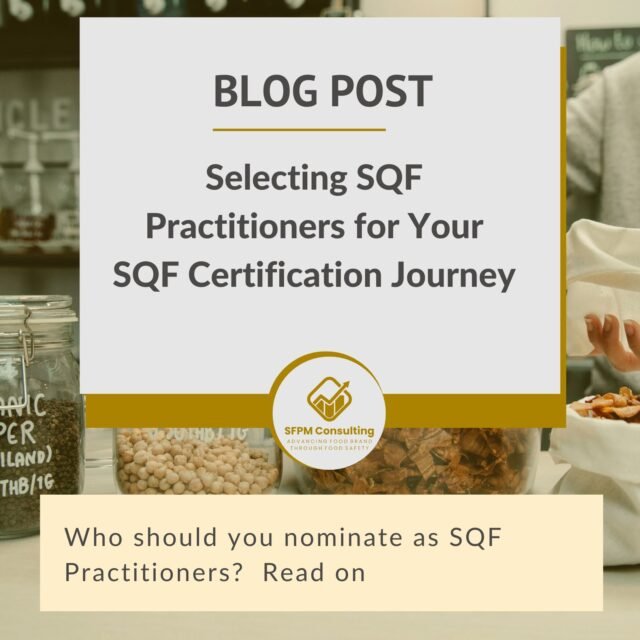To achieve Safe Quality Food (SQF) certification, having the right team is important to help you get there. One of the most critical elements of this team is the SQF practitioner. These professionals play a key role in implementing and maintaining your SQF program, and selecting the right practitioner can make all the difference in achieving certification success.
Step 1: Selecting Your SQF Practitioners
Before building your SQF program, you must select a food safety team. These individuals will implement and maintain your SQF program and ensure that your organization meets all the standard requirements.
It’s important to choose SQF practitioners with experience in the food industry and a thorough understanding of the SQF standard. Look for individuals who have completed SQF training and are familiar with the standard’s requirements.
SQF Practitioners and backup SQF Practitioners are responsible for implementing and maintaining your SQF program and ensuring that your organization meets all of the standard’s requirements.
They can help you identify potential hazards, develop effective control measures, and properly document your program. They can also guide you in training your staff and ensuring your program functions as it should.
If you don’t have an experienced SQF Practitioner candidate, you can nominate two of your staff to go through SQF and HACCP training so they can qualify as SQF Practitioners.
At SFPM Consulting, we provide affordable HACCP training and guide SQF program implementation so you can implement your SQF programs even without experienced staff. We help build your SQF Practitioner’s confidence when managing your SQF programs, so they learn with certainty what to do as an SQF Practitioner.
We understand how hard it is to take on a new role and how important having trustable support is when engaging in the SQF certification journey.
SQF Practitioner requirements:
1) Understand SQF Code
2) Complete HACCP training
Step 2: Building Your SQF Program
With your team of SQF practitioners (and backup) and food safety team in place, the next step is to build your SQF program. This involves developing a food safety plan, identifying potential hazards, and implementing measures and procedures to control those hazards.
Build SQF procedures for each SQF requirement that reflects your organization’s practices.
You can also use our SQF templates that we wrote specifically designed to meet SQF 9.0 requirements or ask a consultant to assist you with program development if you do not have the expertise or time to write these procedures.
We find writing the HACCP plan or US FSMA plan, or CFIA SFCR PCP plan challenging for beginners that have completed HACCP training. HACCP training enables the participants to read and approve food safety plans. Building a food safety plan from scratch takes time and the know-how to get it right.
Don’t burden your new SQF Practitioners; let us help you write your food safety plan. For more program development assistance, contact us here: https://tidycal.com/sfpmconsulting/strategy-call
Step 3: Implementing Your SQF Program
Once your SQF procedures are properly developed, the next step is to implement them. This involves training your staff, setting policies to monitor your program, and ensuring that everyone in your organization understands their role in maintaining the program.
SQF practitioners will oversee implementing your program, ensuring that everyone is properly trained and your program functions as it should.
At this stage, you probably have over 30 procedures and 50 forms to meet SQF requirements. While we don’t need all the procedures and forms simultaneously, navigating these documents can be tricky. That’s why having a trusted consultant that can guide you through these documents can be helpful.
We preselect clients for our implementation program as we want to make sure we have the time to dedicate to each of our support clients, and the program requires client commitment to ensure the program is properly implemented. It takes lots of time and works for both parties.
With our support client, the support program includes procedures development, guidance for each module, food safety training and implementation review and assistance.
Step 4: Maintaining Your SQF Program
Finally, you need to maintain your SQF program to ensure that it continues to meet the standard’s requirements. This involves ongoing monitoring, updating your procedures as necessary, and regular audits to ensure your program functions as it should.
The food safety team will play a critical role in maintaining your program, ensuring that it stays up to date and that any issues are addressed quickly and effectively.
As a general rule, we are looking at three months of records before we have an audit so that you can demonstrate the program is properly implemented.
Rush audits? -talk to us, and we can have you set up your program so you don’t lose out on your retail opportunities.
Achieving SQF certification requires a strong team, and selecting the right SQF practitioners is a critical component of this team. These professionals are responsible for implementing and maintaining your SQF program and ensuring that your organization meets all the standard requirements.
By selecting the right SQF practitioners who thoroughly understand the food industry and the SQF standard, you can improve your chances of achieving certification success.
While hiring an SQF consultant may be an option for some organizations, selecting and training your team of SQF practitioners can be more cost-effective. This can help you build internal expertise and foster a food safety and quality culture throughout your organization. With the right team, you can improve food safety and quality, increase efficiency, and achieve certification success.
P.S.: We are not discussing SQF certification today. If you are looking to see how we can help you with your audit certification requirements, contact us at https://tidycal.com/sfpmconsulting/strategy-call

